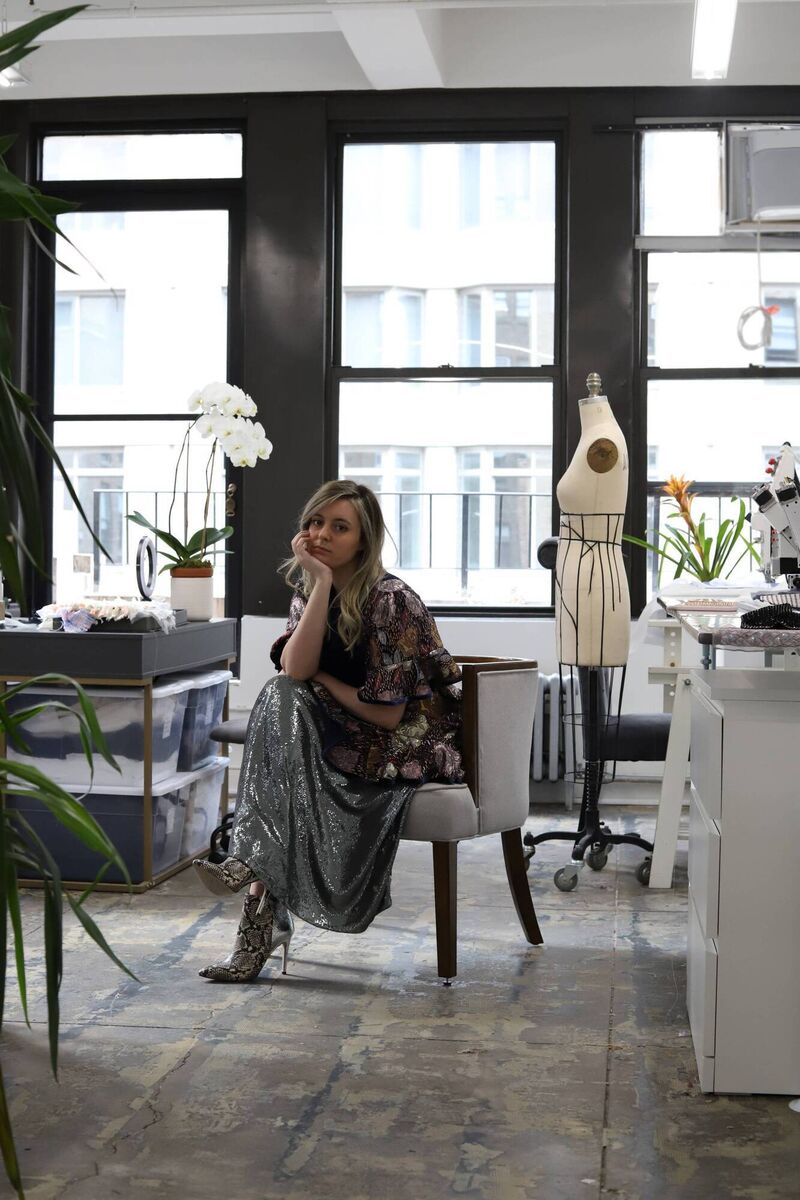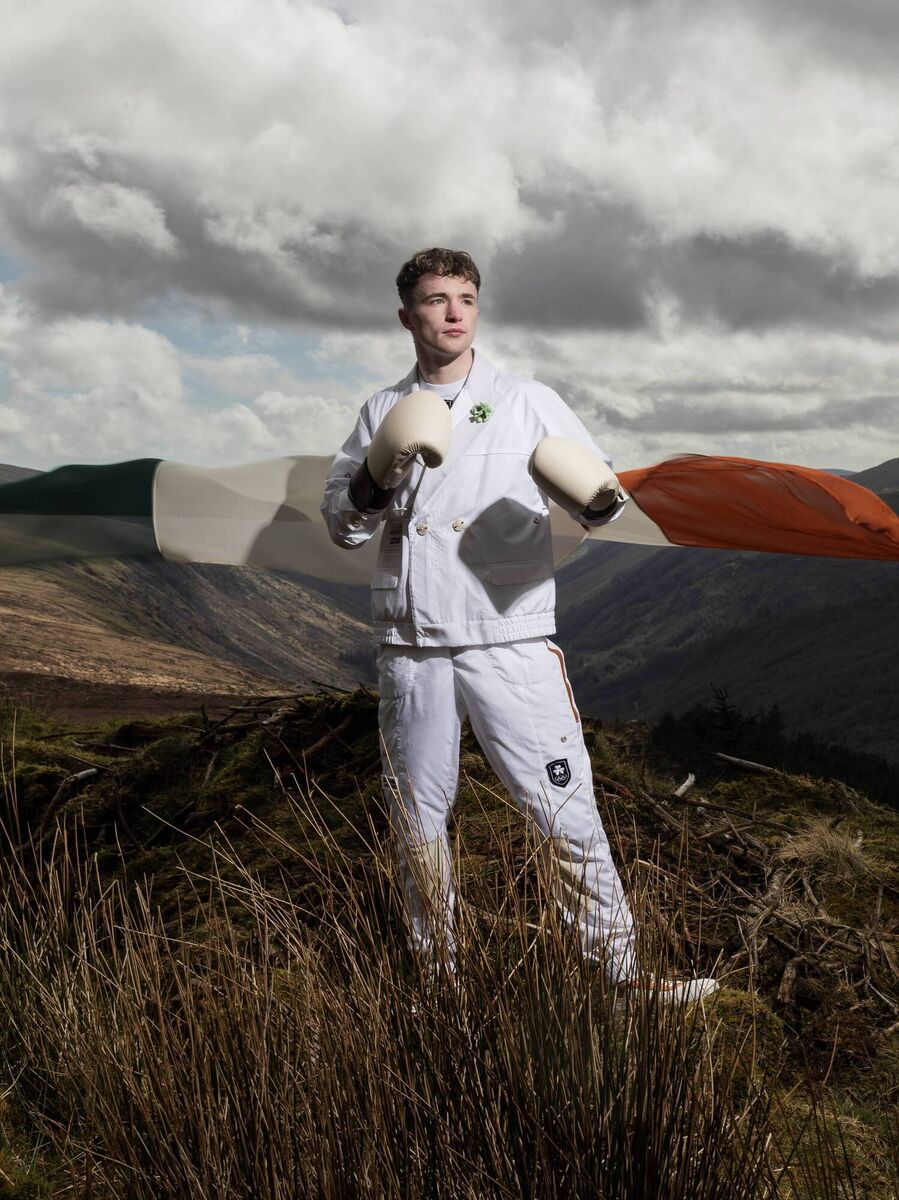For Laura Weber, the Dublin-born fashion designer based in New York City, embroidering Dr Jill Biden’s outfit for her husband’s presidential inauguration in 2021 was just another day.
“I knew it was for Dr Biden,” she smiles via Zoom from her home in Manhattan. “But it didn’t make a difference to me… because I didn’t know how big a deal it would be.”
The ivory coat and silk wool cady dress, which had been designed by Gabriela Hearst, had been hand-embroidered by Weber to contain the State flower of each of the 50 US states and territories as well as a quote by Benjamin Franklin on the inner lining: “Tell me and I forget. Teach me and I remember. Involve me and I learn.”
Like many of the high-profile outfits Weber has worked on since her move to New York some 11 years ago, it involved a last-minute change.
“Originally, it was supposed to be navy. But it was changed at the last minute, because the Capital riot had just happened and Dr Biden wanted to symbolise peace. We had a week to change it. We tried to get to [Washington] DC for a fitting, but no one was allowed in or out, so we ended up doing a remote fitting.”
The outfit — which fashion critic Vanessa Friedman lauded at the time by simply tweeting ‘Boom’ — today joins the most celebrated outfits of First Ladies gone by in the Smithsonian’s First Ladies Collection: an archive comprising of more than 1,000 pieces of clothing, accessories, and other personal ephemera of every First Lady going all the way back to Martha Washington.
The archive, displayed in Washington DC’s National Museum of American History under the title ‘Changing Times, Changing First Ladies’, features Mary Lincoln’s 1861 purple velvet hoop skirt and bodice by African-American dressmaker Elizabeth Keckly; Jacqueline Kennedy’s 1961 yellow silk state dinner dress, designed by Oleg Cassini; and Michelle Obama’s one-shoulder 2009 inaugural gown created by Jason Wu.
“I actually got to be there on the day they opened the collection,” Weber smiles. “I was asked to come see it be put behind the glass. It was incredible — a genuine moment in time.”
Weber grew up the eldest of three to a single mother in the southside Dublin suburb of Rathfarnham, where she became interested in creating from a young age. “Everyone else wanted dolls,” she says. “I wanted colouring pencils.”
She credits her childminder with feeding this creativity, by teaching her to braid, knit, and draw. “My hands were broken in from an early age,” she laughs. “And because of that, I feel like I developed the soft touch needed for fabric when I was still a child.”
Laura Weber: “You know the way people count down the hours until 5pm? I work until 2am almost every night, and keep going if I need to.”
At university, she studied textiles at the National College of Art & Design (after creating a portfolio, from scratch, in a matter of weeks) later specialising in embroidery.
During this time, she worked full-time, regularly in London; for four seasons Weber worked across the business management of London Fashion Week.
In 2013, she moved to New York. The story goes that she landed in the city at 2pm, went straight to the Garment District, and by 5pm was employed. Within six weeks, she’d been promoted twice. Just under three years later, she was the factory’s vice president.
“I got very lucky,” she smiles, modestly. “But I also have always just loved working. You know the way people count down the hours until 5pm? I work until 2am almost every night, and keep going if I need to. At the start, I used to bribe my co-workers with their favourite foods to teach me how to use their machines. And because I used to turn up to the factory so early for work every morning, the building’s super cut me a key.”
She stayed there for six years, eventually burning out.
“I quit my job, which was a very scary jump,” she says.
“But I just needed a break. Then previous customers kept reaching out to me to work with them, but I kept turning them down. At one stage, one offered me so much money for a three-week job that I couldn’t say no.
 Laura Weber: “The only thing that has gotten me here is hard work.”
Laura Weber: “The only thing that has gotten me here is hard work.”
“That turned into eight months. After that, I had interns showing up to my apartment with requests from their bosses, which saw my apartment turn into a mini studio. My husband, then, one day came home and said that I really needed to get my own place, because he could no longer open the front door without hitting a machine. That was October 2019, six months before the pandemic, and LW Pearl Atelier was born.”
LW Pearl Atelier is a couture, premium manufacturing service for fashion designers, wherein Weber and her team interpret a designer’s vision with bespoke stitching, beading, and other embellishments.
“Designers come to me with a sketch or concept and we product-develop it into a final piece.”
Heading up a team of craftspeople, each with specific, specialist skills and workmanship, Weber’s team endeavours to complement the vision and design of internationally recognised designers such as Marc Jacobs, Proenza Schouler, and Thom Browne.
“We do a lot of stuff for the Met [Gala] or the Oscars or Fashion Week, that kind of thing,” she says.
“It grew out of just pure love for what I do.” LW Pearl Atelier also creates clothes, too; at present there are two collections, athleisure and ready to wear. “That came from me being so in touch with other designer’s aesthetics and visions, that I started thinking about my own. I was like: ‘I need to do my own thing to keep this specific part of my brain alive’.”
In 2021, Weber was tasked with another high-profile project; designing the official outfit for Team Ireland at the 2024 Olympic Games. She had worked across Team USA’s official kit before, teaming up with Ralph Lauren and Versace to hand-stitch pieces for both the summer and winter Games. In 2021, she directed her gaze homeward, pitching her design concepts to the Olympic Federation of Ireland.
“It was kind of controversial,” she smiles. “Because I wanted each person’s outfit to be personalised with a patch denoting their county on the forearm. I never wanted it to come from a political place, or for anyone to feel divided, so I spoke to some athletes to figure out whether they’d be interested, and they were all for it. They thought it was so cool.”
 Boxer Dean Clancy modelling LW Pearl by Laura Weber for Team Ireland Paris 2024 Olympics. Picture: Matthew Thompson
Boxer Dean Clancy modelling LW Pearl by Laura Weber for Team Ireland Paris 2024 Olympics. Picture: Matthew Thompson
From this, she made careful design considerations that go beyond fashion, invoking national pride, unity, and cultural representation; inside each jacket reads the name of the athlete in embroidery, as well as a leather shamrock charm that Weber created for each athlete to keep as a memento.
“There’s something really special in Ireland about having county pride as well as country pride. Go to any small town in Ireland and they’ll be able to point out the pool where such-and-such swam, or the roads another athlete ran. That’s incredibly important, so I wanted to honour that aspect too.”
Weber also considered the practical and environmental. “Finding a fabric to do everything they need to do was so hard,” she laughs.
“We were back and forth for months. Eventually we chose this performance fabric that is 100% recycled material, which is light enough to keep them from dying in the heat of a Parisian summer.”
The closing ceremony jacket showcases Weber’s eternal optimism. “I made the strapping on the jackets into the shape of a star,” she smiles.
I notice here she says “when”, and not “if”. I put it to her, and she smiles again. “When you’re a business owner, you have to be the eternal optimist. Everything is going to be better tomorrow.”
For the young creators, designers and optimists reading this story and envying Weber’s far-reaching achievements and impressive CV, she has this to say: “The only thing that has gotten me here is hard work. I am not in stilettos every day, and life is not . The days you need to work your hardest are the days that you want to go home and go to bed. I truly believe that in fashion, you have to stay until after everyone leaves, because if you don’t, there are 50 others waiting in the wings.
“On top of that, being a nice person is really important. Fashion has a really bad reputation. But at the end of the day, you’re dealing with other people. And those people just won’t want to work with you if you’re not nice.”
Being realistic is also really important.
“We’re not saving lives here,” she laughs. “It’s important to remember that it’s not everything. I have a mum and three sisters who will always take me down a peg or two. I think Irish people are particularly good at that.”


